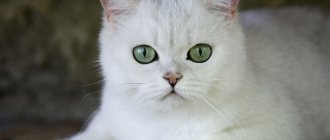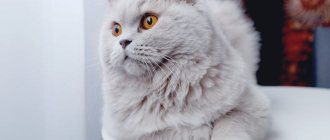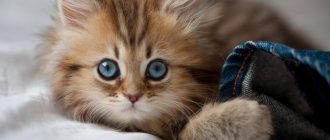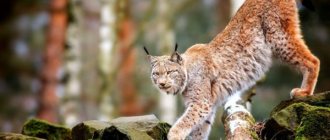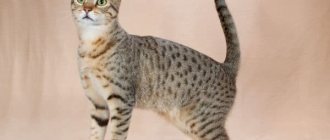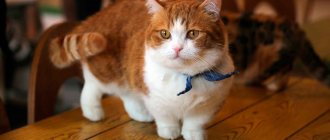Cats usually give the impression of being affectionate and friendly animals. However, some of them are quite aggressive and can cause serious injury. Therefore, in order not to fall into the unpleasant statistics of pets injured by claws, before buying a tiny, cute kitten, it is worth finding out more about the character of the chosen breed. And information about which of the existing varieties of cats are considered the most dangerous in the world will help with this.
The most dangerous cats in the world: characteristics
The love for exotic, rare pets, the desire to impress guests with an unusual animal living in the house has led to people getting cats that are completely unsuitable for apartment keeping.
The action leads to inconvenience. Wild animals spoil the design of housing, avoid people, get sick, experience chronic stress, and some representatives are quite dangerous for the owner and his family.
Small spotted cat
Well, very expressive eyes
Her middle name is Oncilla. Small, very cute and quite rare animals, distinguished by their particular bloodthirstiness.
These spotted predators live in the tropical forests of America. Elegantly built, resembling a miniature leopard with a sullen expression, oncillas love to spend the daytime in idleness. Namely, rest on tree branches, hiding in the shade. Small spotted cats prefer to be nocturnal. When the sun goes below the horizon, oncillas turn into bloodthirsty four-legged furies. Representatives of this species are known for their increased aggressiveness.
Fortunately, animals practically do not see people. Despite their size, and the cats weigh only 2-3 kg, oncillas attack humans without hesitation. These forest dwellers will not be embarrassed at all by the fact that the enemy is much larger and stronger than them.
Savannah
Cats seem to have stepped out of ancient Egyptian frescoes: graceful flexible body, long legs and neck, small head, pointed ears.
The thick, short, spotted coat makes the cat look like a miniature version of a leopard. Savannahs tend to show a sharp character, wild habits, and aggressiveness. They may perceive strangers and other animals as objects of hunting. They can only be walked on a leash.
Turkish van
The ancestors of the Turkish Van are aboriginal semi-long-haired cats, who from time immemorial lived in the area adjacent to Lake Van, located in Turkey. This breed was discovered in the modern world by British journalist Laura Lushington, a big cat lover. From her trips to this region of Turkey in the 50s of the last century, she several times brought charming kittens, with which the breeding of the Turkish Van cat breed in Europe began. Today, the Turkish Van is recognized by all leading felinological international organizations.
An adult Turkish Van cat can weigh up to 9 kg. His body is muscular, long, with a wide, powerful chest. These pets love water fun and swim well. They are very active, sociable, overly inquisitive and emotional. They have a well-developed hunting instinct. In childhood and adolescence, these cats can even show some aggressiveness, biting and scratching their owners. However, with age their character becomes softer.
In Turkey, aboriginal Van cats (they are called van kedisi here) are very revered, are one of the symbols of the country and are listed in the Red Book. They are credited with the gift of bringing happiness and good luck; these animals are even allowed to enter the mosque. It is possible to export Turkish Vans from the country only with official permission.
Turkish van
Abyssinians
The breed is suitable for people who are not ready to constantly communicate with their pet and do not expect excessive affection from it. The Abyssinian will take care of herself very well, prefers solitude, does not like to be cuddled, forced to play, and hides on closets and other high places in the apartment.
She has a developed intellect, is capable of learning to walk on a leash, fetch, and other commands, but tends to be quick-tempered.
Playing with her is fraught with scratches and bites. Having been punished, she is offended and vindictive. She is inquisitive, active, and if she picks up the key to her prickly character, she gets a devoted friend.
Abyssinian cat
Beautiful purrs with a tri-color effect. It became one of the most evil cat breeds due to its vindictiveness and tendency to play aggressively.
He loves his owner devotedly, but even more loves to play with furniture and doors. He does not see his guilt in damaged things and will take revenge for punishment.
Amenable to education and training. After due effort from the owner, the Abyssinian cat can be trained to walk on a leash and fetch things on command. But without education, the animal becomes uncontrollable. With care and understanding from humans, they become wonderful pets.
A smart baby will cost about $400.
Manul
A wild cat does not live well in captivity. Kittens taken into the home, even with constant contact with people, remain wild, strive for solitude, and hide in secluded places.
An adult animal looks brutal, resembling a lynx. It reaches a height of 65 cm, weight up to 5 kg, but due to its thick, long, lush fur it gives the impression of being “robust”. Even in zoos, breeding Pallas' cats is rarely successful; most of the offspring die.
Long claws, sharp fangs, agility, and physical strength that help the Pallas' cat survive in the wild will cause a lot of trouble for the owner. The animal does not need the company of its relatives, does not like children or other pets living in the house. Can perceive a domestic cat or a small breed dog as game.
Be sure to read:
How cats treat people: 4 ways, basic rules, what breeds, what diseases they get rid of
You can read more about the Manul breed here
and here's another thing: Is it possible to train a Pallas's cat?
Maine Coon
Of the domestic cats, the largest is the Maine Coon, which has a massive body and a wide chest. A non-obese Maine Coon can weigh up to 15 kg. They are often bred as exotic cats. But they may not be harmless, sometimes they can show aggression, and the large size of the cat can mean more serious injuries. If a stranger enters the territory of the house, the Maine Coon may meet him aggressively. But at the same time, breeders note their flexibility and high intelligence - Maine Coons can pick up on the intonations of their owners and respond to their requests.
They are very curious and therefore require close attention to themselves. They don’t like to be left alone, so if a Maine Coon needs to be left alone for a while, then you should provide it with toys, otherwise the owners will later regret leaving it. Maine Coons do not require special conditions to keep; they feel good in any climate. But during walks you should not leave them alone, as their mood can instantly change.
Siberian cats
Fluffy, handsome dogs with thick long hair, powerful paws, large muzzle and body. The weight of an adult cat is about 6 kg, and that of a male cat is 12 kg. The character corresponds to the name of the breed.
Loyal and devoted to their owner and his family, animals are full of inner dignity, do not tolerate familiarity from strangers, and will not allow themselves to be offended. They are friendly towards other animals and lenient towards children.
They are amenable to training, quickly adapt to the rules established for them, but in some moments they can be strictly principled. They need free space, personal territory, the opportunity to show natural instincts, and hunt.
Read more about Siberian cats.
Causes of aggressiveness in cats
Cat rage can be triggered by several factors, the most common of which are:
- illness and poor health;
- fear of people;
- hunting instincts;
- self-defense;
- genetic predisposition.
Any cat is, first of all, a predator with its own needs and instincts, which can manifest themselves at any moment. This should always be remembered, especially if you decide to get a pet from the list of potentially dangerous and aggressive breeds.
Bengal cats
From early childhood, Bengal kittens need their owner's love, attention, and a warm atmosphere. Very mobile, active, they retain the desire to play and hunt until old age. They can climb curtains, damage furniture, without being able to splash out energy in a peaceful direction.
You can’t shout at them, much less hit them. Grievances are remembered for a long time. The character of the Bengal breed is explosive, impulsive, and prone to revenge. Breeders know many cases of a pet attacking its owner, affecting the cat's pride.
The Bengal breed should be raised patiently, using affection, kindness, taking into account the animal’s independence of character and love of freedom.
For those interested, you can look at the size and weight of the Bengal by month. and you will find a lot of new and useful things there.
Early communication
It refers to communication between a kitten and a person. But you need to clearly understand that until the baby is 8 weeks old, you cannot separate him from his mother. Eight weeks is the minimum period to begin socialization. At this time, the cat is already ready to learn play and hunting skills, he can learn good behavior during grooming, and is ready to learn the norms of behavior in the cat community. Finally, 8 weeks is when the kitten is ready to feel confident. Those babies who were separated from their mother too early have excessive aggression. It is very difficult to make such a cat affectionate.
Kittens separated from their mother early are aggressive, fearful, distrustful, and also emotionally unstable. Aggression is the most difficult case, since such a cat has little chance of becoming kind and docile. But early separation from your mother cat can be compensated for!
Let's consider what the owner needs to do.
- When you adopt a kitten, create an environment around it that will not change every day. They say that a dog gets used to its owner, and a cat gets used to the house. There really is a lot of truth in this. If everything changes in his room (more precisely, in the one where he is most often), if you constantly offer him new beds and toys, he will be confused. Then confusion will be replaced by wariness, and then aggression is not far away.
- You can teach a cat to be affectionate and agreeable only if the person himself is calm, predictable for the cat, and stable. Whatever one may say, without this it is impossible to achieve what you want. You need your pet to stop being afraid of you, to respond well to your voice, to know your habits, etc.
Jungle cats
A large breed, the weight of an adult reaches 15 kg. Jungle cats are not completely domesticated, even when raised in a human family from a young age. They do not like to be touched or stroked; they prefer to spend time alone, minding their own business.
It rests during the day and is active at night. Keeping a predator in an apartment is a dubious undertaking; it will happily jump around, demolishing vases and decorative items along the way, use curtains to climb higher, and repeatedly sharpen its claws on furniture, leaving deep marks on the upholstery.
If you really want to have a pet with the appearance of a lynx, it is better to place it in a spacious enclosure.
Top 10 dangerous breeds
In addition to peaceful and friendly cat breeds, there are also those that are endowed with a willful and cocky disposition. Such pets are poorly adapted to living together with people and, under certain circumstances, become very aggressive and unsafe. When enraged, these cats can cause no less harm than a poisonous spider or an angry dog.
The list of the 10 most dangerous breeds includes:
- savannah;
- manul;
- Abyssinians;
- Siamese;
- Maine Coon;
- British;
- Siberian;
- Bengali;
- chausie;
- reed
Savannah
These large graceful animals are considered one of the most dangerous cats in the world. Although Savannahs can be tamed, there is always a risk that they will become aggressive.
The owners of these cats must always be on alert, because their graceful pets often perceive strangers as objects of hunting.
Manul
This wild feline is similar to a lynx and is completely untamed. Even a manul raised in captivity will avoid people. These aggressive and dangerous cats are not suitable for home keeping.
No matter how hard you try, it is impossible to teach wild Pallas’ cats commands and stop them from damaging their owner’s property.
Abyssinians
These sophisticated oriental beauties also belong to the category of dangerous cats. It turns out that representatives of the breed are very vindictive and immediately take revenge for insults inflicted on them. Without proper attention, Abyssinians become wild and aggressive.
Siamese
These cunning and dangerous cats are very aggressive and vindictive. They can harbor a grudge for a long time and take revenge at the most unexpected moment. Siamese cats do not like excessive attention and do not tolerate familiarity. It is not advisable to take representatives of the breed into families with children.
These cats pose a real danger to children who do not yet know how to properly handle a pet.
Maine Coon
These smart and flexible animals are endowed with a changeable disposition and can begin to take revenge even for a minor offense. Large and dangerous Maine Coon cats cannot stand loneliness and, due to their size, are capable of crippling a person.
British
This cute domestic cat is endowed with an independent and willful character. The proud and freedom-loving Briton has no love for strangers and prefers to distance himself from them. He can hardly tolerate being picked up or forced to play.
Siberian
This large and quite dangerous cat is wary of strangers and can only get along with someone who has a highly developed sense of self-esteem.
An independent and strong Siberian can be both affectionate and sensitive, and aggressive. To smooth out developed hunting instincts and avoid unwanted behavior, this cat must be trained from an early age.
Bengal
This impulsive and dangerous cat has highly developed hunting instincts. To prevent a Bengal kitten from becoming an aggressive monster, it is raised in a calm atmosphere.
An active and mobile animal does not like to be forcibly held in arms and does not tolerate being addressed in a raised voice. An angry Bengal cat can be unsafe and capable of causing serious damage.
Chausie
These powerful animals, more like a puma, also belong to the category of aggressive and unsafe breeds. Aggressive cats need to be dealt with constantly and dangerous games should not be played.
Chausies have developed hunting instincts, do not tolerate confined spaces and are not suitable for apartment living.
Read the detailed article – “About Chausie cats.”
Reed
This aggressive and dangerous cat with the appearance of a lynx is practically impossible to domesticate and is difficult to train. She needs constant communication, and if there is a lack of it, she quickly runs wild.
Aggressive cat breeds: features, how to influence
Some domestic cats have a naturally explosive temperament; before choosing a specific breed, you need to familiarize yourself with its character and understand whether it matches the conditions in which the future pet will live.
If there are children in the family who will be allowed to constantly cuddle and stroke an animal that has a love of independence and personal space, you should not scold it later for the scratches and bites left on the hands of your son or daughter.
Be sure to read:
3 cat breeds with different eye colors (heterochromia)
Many people, when getting a pet, do not think about the consequences. For example, a lot depends on the character of the pet, especially its further relationship with its owners. We are responsible for those we have tamed. For example, the most popular pets are cats. Many people love these furry animals, few will remain indifferent, and there are those who recognize only them. What if you find out that there are dangerous breeds of cats that can cause severe harm not only to property, but also to your health?
Let us immediately make a reservation that the information in this article is for general informational purposes only and may not be applicable to all representatives of the breeds listed below. Just like people, each cat has its own character, there are exceptions to the rules, but there are also characteristic features common to the breeds.
1st place – Manul
The Manul cat breed is undoubtedly incredibly charming. And even once a picture with Manul became an Internet meme. The appearance of this big fluffy cat is as if it was created in order to cuddle it. But don’t delude yourself – these Pallas’ cats are quite dangerous and very difficult to tame. These fluffies are very secretive and independent. Pallas's fangs are 3 times larger than those of other cats. There is probably no need to explain what this entails?
2nd place – Savannah
Second place goes to the Savannah cat breed. They were bred as a more compact version of the African Serval. Savannahs are quite expensive animals. Also, these cats are so big that they can be walked on a leash like a dog. In general, adult Savannah cats are very kind and intelligent, but young cats can attack strangers, showing the wild nature of their breed.
3rd place – Chausie
The Chausie breed is the result of crossing a wild swamp lynx with the Domus cat breed. Such freedom-loving cats need a lot of space and freedom. So, if you live in a small city apartment, then it is better for you not to consider Chausie as a pet, they are capable of destroying it in a short time. But, if you raise Chausie correctly while still a kitten, there is a chance of raising a well-mannered and obedient animal.
4th place – Stone Cougar
The Stone Cougar was created by crossing the Domus cat breed and the jungle cat. These are quite large animals. One of the remarkable features of this breed is that the Cougar recognizes only 1 owner. This means that in relation to other family members, guests, friends and other people, Stone Cougar will be secretive and aggressive.
5th place – Jungle cat
The jungle cat can weigh up to 15 kilograms. This is a wild, undomesticated breed that is unlikely to become an easy-going pet. Despite this, some people like the tufted ears and color of jungle cats so much that they still tempt fate... Here are the main problems that arise with. You won't be able to pet them, because... The jungle cat really doesn't like this. Also, the wild nature makes itself felt - these animals will attack everyone and everything.
6th place – British Shorthair
It would seem, why did we include the British in this list? These are cute fluffy cats, which “not only everyone loves, few people can not love them” (c). If you are lucky and have seen kind representatives of the British Shorthair breed, do not flatter yourself, in fact, for the most part they are very independent cats. Although the British are very popular and look like incredibly cute fluffies, they are very capricious. For the most part, they cannot stand squeezing and lisping, and can react sharply to this and even throw themselves.
7th place – Maine Coon
Maine Coon cats look very stately, noble, gentle and kind. Tassels on the whiskers, a muzzle shape that is not typical for domestic cats, weight up to 15 kg. Some people recommend having these giant cats as friends for small children. This can be a rash step, because... The Maine Coon is a rather capricious and unpredictable breed. If they pester him excessively, after a while, or perhaps immediately, he may take revenge. And based on the size of the animal, you can guess the consequences.
8th place – Abyssinian cats
Abyssinian cats, unlike Maine Coons, take revenge immediately in most cases. And if they are not given enough attention, they can quickly go wild. Sometimes there are cases that an Abyssinian can attack just like that, without any reason.
9th place – Mekong Bobtail
The Mekong Bobtail is a very old breed that has undergone little crossbreeding. Outwardly it may seem that these are kind cats. But this is wrong, because... their ancestors are Siamese cats, not known for their good disposition. So, Bobtails are secretive, dangerous and independent. They can cause unpleasant injuries even just during a harmless game. They also don’t like strangers, so any guest can become enemy No. 1 during their visit.
10th place – Siamese cats
The leader among rumors about rancor and aggressiveness among domestic cats is the Siamese breed. Probably every person is familiar with this stereotype. However, these cats, with their very beautiful coloring, are quite popular as pets. And, unfortunately, rumors about rancor and an evil character are confirmed in practice. Many owners are almost never without scratches and bites. If a Siamese cat harbors a grudge against you for some kind of insult, it’s good if she takes revenge only once, because... in the worst case, you can become the enemy of her entire life and he will not give you a pass.
Of course, a lot depends on the character, but how you raise and raise your cat is also important. Which breed to choose is a matter of taste for each person, but always remember that a cat is a predator, and “a cat walks on its own.” And our hotel for cats “Pets in Joy” will gladly accept your pet and find an approach even to its specific character.
Persian cat
The look and expression of the Persian's muzzle evokes thoughts of a complex, unvarnished character. The breed standard states that purebred specimens must be calm, balanced, and not show active aggression towards people and animals.
Cats are pride creatures; they are not leaders in a pack of people, but they do not assign themselves the place of “omega.” They choose the main owner, and the rest are condescendingly tolerated. It is not possible to influence the choice; the Persian will decide for himself who to give his love, purring, warmth.
The fluffy handsome man cannot live without human company; from long loneliness he begins to get sick and becomes sad. They get along well with children, as long as they do not turn the animal into a toy.
A Persian can show aggression in an extreme situation, defending himself from pain, intrusive attention that goes beyond the boundaries of common sense, and experiencing fear.
Chausie
Chausie cat breed
This is a new breed of cat, bred by crossing a domestic Abyssinian cat with a wild jungle cat, and was registered in 1995. Breeders wanted to get a new breed that would retain the appearance of a wild cat, but have the character of a domestic cat. Externally, the Chausie is similar to a cougar; they have a powerful, slender body, much more powerful than that of most domestic cats. Cats of this breed are ready to hunt around the clock. Families who dare to adopt a Chausie kitten are subject to strict requirements, given the aggressiveness of these animals. People should, from childhood, prevent any attempts to play dangerous games with chausies. Otherwise, this breed can be called very inquisitive and even kind. This breed is characterized by a balanced temperament, developed intelligence and self-esteem. You should not have chausie in small city apartments, as they need a lot of space. They do not strive for privacy; on the contrary, they try to attract the attention of any person. They need regular training, especially since they love heights, which can damage some fragile household items that are best removed in advance.
Ocicat
The breed received official registration in 1987 and is a derivative of a mixture of Siamese, Abyssinian and American Shorthair blood. The appearance of Ocicats is colorful, reminiscent of wild cats. Personality: sociable, inquisitive, friendly. Read more about Ocicats in our article.
Pets are “talkative” and express the entire range of emotions with their voices. Not receiving enough attention to the person, they begin to sing, meow, influencing the owner in every way, reminding them of themselves. They have a tenacious memory, a remarkable mind, and quickly figure out how to open a refrigerator or closet door. They are easy to teach funny tricks. They are playful, active, aggression is not a characteristic feeling for them.
Possible causes of aggression
All known cat breeds can be classified as predators, since all living creatures have aggressiveness, only in some it is weakly expressed, and in others it is stronger. Different experts explain aggression in different ways.
If we consider the main reasons why a creature becomes embittered, these include:
- Pain.
- Fear.
- Territorial division.
It is impossible to say unequivocally which breed ranks first in the ranking of the most aggressive ones; we can highlight a list of those whose natural essence does not disappear over the years.
Quite often, furry owners sincerely do not understand why their beloved cat becomes uncontrollable and angry, because they feed it, love it, care for it, pay attention to it, but it bites every time you try to pick it up.
There are many reasons why the tailed pet has such a character. The most common thing is that an adult is taken from the street and is trying to be tamed. In survival conditions, cats become more aggressive, and they stop trusting people. The second common case is when a person forcibly forces a pet into contact and takes it in his arms. Even if the animal is in your arms, this does not mean that at a given moment in time it is not experiencing stress.
It is also impossible to exclude the physiological characteristics of the character of each individual breed. You must either put up with cat aggression or abandon such a pet. Nevertheless, care for the animal must be shown from birth, this is the only way to prevent an unexpected outburst of aggression towards other people.
Turkish Angora
The most delicate snow-white cloud with huge eyes - this is how you can describe these stunningly beautiful cats. Their fur is silky, delicate, flowing between the fingers like silk, does not require special care, and is not prone to tangles.
At the end of the last century, individuals were selected for breeding solely on the basis of external characteristics, paying little attention to character. Often at exhibitions, Angora cats hissed at strangers and could scratch or bite an expert who picked them up.
Hence the assertion that the breed belongs to the aggressive ones was born. Over time, breeders paid more attention to issues of character when mating, and today beautiful cats of purebred lines have a pleasant sociable nature, love affection, and are willing to make contact with humans.
Dune cat
King of the Dunes
In the once popular song of O. Gazmanov, the khan urged the tramp not to go to the dune. Motivating the call by the fact that the flowers needed by the tramp do not grow on the dune. In fact, not only do flowers not grow on the dune, there are also cats there that are very aggressive towards people.
It is possible to meet a sand cat, but it is difficult. Its habitat is semi-deserts and rocky deserts with shrubs. Dune cats are found in North Africa, Central and South-West Asia, and the Arabian Peninsula.
Representatives of the species have an unusual appearance. Thanks to its wide head and large ears, from afar it may seem like a fennec fox is in front of a person. But the fox will be larger in size than the cat. In general, the desert inhabitant is considered the smallest among its predatory counterparts. The maximum weight that an adult cat can reach is 3.5 kg, and the height at the withers varies from 25 to 30 cm.
If a person is lucky enough to get into the desert and he sees a cute, dirty red cat with huge eyes, there is no need to run to the animal. The fact is that the sand cat, despite its diminutive size, is extremely aggressive and dangerous to humans.
The desert dweller attacks quickly and sharply. The harbingers of an attack are the ears laid back, pressed to the head, the animal gathers into a ball, makes a loud sound similar to a growl mixed with meowing and jumps forward. A representative of the species, of course, will not kill a person, but it is capable of causing serious injuries.
The main danger of the sand cat is its sharp claws and teeth, which are necessary for survival in the desert. After all, the animal has to hunt monitor lizards, geckos and even snakes. And jerboas, local hares and mice are frequent guests on the dune cat’s dinner table.
Ukrainian Levkoy
The only breed bred in Ukraine, it was formed from the love of the Don Sphynxes and the British Fold. The exotic combination of a naked body and small pendulous ears captivated visitors to the exhibition, where the Levkoy was first shown in 2005.
They got their name due to the similarity of the structure of the ears with the flower of the same name.
Hairless Ukrainian cats, despite their spectacular appearance, are simple in their maintenance and not whimsical. They have an extreme degree of curiosity and will not miss a single, even the most insignificant event in the house.
Be sure to read:
How many toes does a cat have: the norm on the hind and front paws, possible pathologies
They have a balanced temperament, get along well with children and other pets, and show interest in guests.
The main gentleman is loved to the point of unconsciousness, following on his heels; the rest of the family members are also not deprived of attention and affection. Levkoys are not at all vindictive; aggression can manifest itself in extreme situations or in the kitten’s puberty, but usually does not go beyond limits.
African golden cat
Golden cat on the hunt
The closest relative of the caracal and serval. The golden cat lives in the forests of West and Central Africa. The animal is quite large, weight can reach 15-18 kg. The appearance of the predator is magnificent: flexible body, color varying from deep red to red-brown. Expressive, pale blue eyes add additional beauty to the animal.
Despite their stunning appearance, there are very few people in the world who like keeping golden cats indoors. The fact is that the predator requires a large space and a house designed in such a way that the cat can freely enter and exit it. And such a pet is not distinguished by its sweet character.
Let's start with the fact that the adult does not take root in captivity. But a kitten can only be purchased illegally, because there are no nurseries that breed these animals. Buying a kitten from poachers is fraught: the animal may turn out to be sick, you will have to pay for it like for a Boeing wing, and it is not a guarantee that the animal will be tamed.
African adult cats behave extremely aggressively in captivity. The peculiarity of the animal is that it rushes at a person without warning. And such a pet, when attacked, beats its tail so that a person will not find it too much.
Siamese cat
The statement about the viciousness of the Siamese is partly true. The character of these cats is picky and complex. An animal can completely love its owner, but also become disappointed in him when faced with rudeness or the use of physical or moral violence.
In this case, a small but proud animal will really take revenge with all the cat’s strength, shitting in slippers, spoiling objects, and attacking openly.
Siamese have a hard time with loneliness, succumb to attacks of jealousy, are distrustful of strangers, and if a guest tries to get too close and too intense, they can resist.
Here are the TOP 10 cats similar to Siamese.
Hairless cats
Bambino
This is the fruit of crossing a short-legged munchkin and a hairless sphinx; it turned out to be squat and hairless. Representatives of the breed have a very touching, defenseless appearance, which is why they were named like small children - bambino. By the way, long-legged kittens may also appear in the litter of these cats.
These cats are not hunters, so they do not show aggression during play. This allows bambino to be kept in the same nest even with mice. They are gentle, affectionate and playful.
Don Sphynx
Representatives of the breed have a very exotic appearance, however, they were bred in Russia. Cats do not have fur, they are very elegant, but have developed muscles.
The Don Sphynx is very inquisitive, active, but not mischievous. He chooses one owner whom he adores. He finds a special approach to the rest - he knows who plays with him, who feeds him.
Canadian Sphynx
Folded and bald, however, having won love and reverence, the Canadian Sphynxes look very distinctive. They have warm, soft skin that is pleasant to touch.
As for their character, they are very gentle and devoted, are not jealous of other animals and are not aggressive. They have pride, so they will not humiliate themselves and beg for a treat. But they will definitely try to pull it off.
Peterbald (Petersburg Sphynx)
The birthplace of the breed is the northern capital, where hairless cats with a model appearance appeared. Short-haired Peterbalds may also be born, but in character they are not at all different from their hairless counterparts.
These cats will wake you up in the morning, take you to work and greet you joyfully. They are friendly to all family members, but the pets simply idolize the owner. The advantage is their cleanliness, the disadvantage is excessive “talkativeness”.
Ukrainian Levkoy
A rare breed - its representatives are hairless and fold-eared, very attractive to lovers of unusual cats. Levkoys have a serious, and even angry, appearance, which has nothing to do with their character.
Cats are loving, gentle and loyal. They are easy to train, cheerful and positive, but demanding. It won’t be difficult for them to follow their owner’s heels, putting their backs up or jumping on their laps - they will definitely get their share of affection!
Cats are one of the most amazing and extraordinary pets. They may have different appearance and temperament, small and not very weak, but in any case, they get along with a person and become part of his family.



